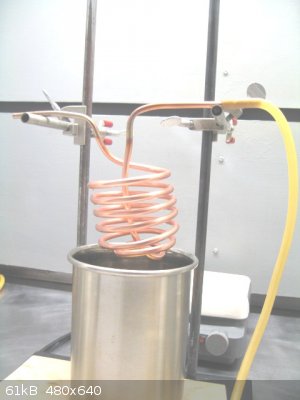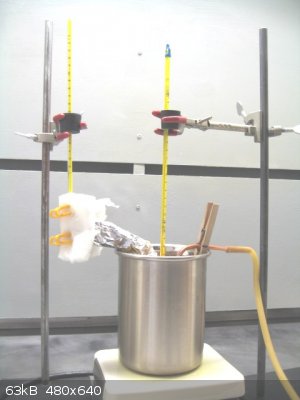Magpie
lab constructor
    
Posts: 5939
Registered: 1-11-2003
Location: USA
Member Is Offline
Mood: Chemistry: the subtle science.
|
|
gas heater
I constructed an oil-to-gas heat exchanger using a copper coil immersed in heated oil as shown in the pictures below.
The coil is made from 1/4" (ID=0.19") refrigeration tubing. The coil ID is 3"; submerged length is 5.5 feet. Heat transfer fluid is safflower oil
heated to 240°C.
My test gas was argon. I measured the gas flow using a Dwyer rotameter, 0-2 SCFH (0-15.7 ml/s).
On my first test I could not get the gas temperature above 65°C at 2 SCFH. On the second test I insulated the outlet tube and thermometer, as shown.
Then I was able to get the gas temperature to 140°C at 2 SCFH. Temperature would drop significantly at 1 SCFH.
At the lower flow rate the gas temperature should be higher. I think the main problem is proper measurement of the outlet gas temperature. I don't
think that my measurement is accurate.
My calculations show that this coil should easily heat the gas to a high temperature, even using a conservative assumed overall heat transfer
coefficient.
 
The single most important condition for a successful synthesis is good mixing - Nicodem
|
|
|
Sulaiman
International Hazard
    
Posts: 3692
Registered: 8-2-2015
Location: 3rd rock from the sun
Member Is Offline
|
|
I can't think in Imperial so
0.19" id = 0.4826 cm, cross-sectional area = 0.183 cm2
2 SCFH = 15.7 ml/s = 15.7 cm3/s
flow rate = 15.7 / 0.183 = 85.83 cm/s
5.5 feet = 167.6 cm,
so heating time in tube= just under 2 seconds.
thermocouples cost GBP1 with postage so can be 'sacrificed'
clamp/bind/weld 2, 3 or more to the copper pipe in strategic places and maybe in the silicone tubing to measure gas temp.
many multimeters have a temperature range
a REX C-100 used as a thermometer is less than GBP7 and is easy to find a use for later
(if you go this way, the controller/ssr/probe package is better value as small relay contacts fail quickly at higher currents)
(note: the C100 has no alarm output for unattended operation)
[Edited on 1-2-2016 by Sulaiman]
|
|
|
Magpie
lab constructor
    
Posts: 5939
Registered: 1-11-2003
Location: USA
Member Is Offline
Mood: Chemistry: the subtle science.
|
|
Yes, the residence time is very short, as you say just 2 seconds.
I agree that a very small TC that could be inserted into the insulated outlet should give the best indication of the true temperature. I have 2ea
type K TC's that I often use for my experiments but I have assumed they are too big to use. I need to check that out.
It was very interesting to me playing with such a low flow as 2 SCFH. This flow is so small that I could barely detect it with my finger as the argon
came out a 1/4" hole. So I checked it out by using water displacement in a 250 ml gas washing bottle. It was amazing how fast that tiny flow emptied
that bottle! The Dwyer rotameter reading was indeed verified as accurate.
The single most important condition for a successful synthesis is good mixing - Nicodem
|
|
|
m1tanker78
National Hazard
   
Posts: 685
Registered: 5-1-2011
Member Is Offline
Mood: No Mood
|
|
I'm sure this is version 1 but how about filling the copper tube with inert loose packing? If you must use oil you'd benefit from stirring/circulating
IMO.
Chemical CURIOSITY KILLED THE CATalyst.
|
|
|
Magpie
lab constructor
    
Posts: 5939
Registered: 1-11-2003
Location: USA
Member Is Offline
Mood: Chemistry: the subtle science.
|
|
I have not tried packing. Thanks for the idea!
The oil is heated on my mag stirrer so was well stirred.
The single most important condition for a successful synthesis is good mixing - Nicodem
|
|
|
Bert
Super Administrator
        
Posts: 2821
Registered: 12-3-2004
Member Is Offline
Mood: " I think we are all going to die. I think that love is an illusion. We are flawed, my darling".
|
|
Is your ultimate aim to use the heated Argon for some heating process? Because it has rather different heat transfer characteristics than most other
commonly available gasses... Particularly if convection is to be used.
http://www.decompression.org/maiken/Why_Argon.htm
Rapopart’s Rules for critical commentary:
1. Attempt to re-express your target’s position so clearly, vividly and fairly that your target says: “Thanks, I wish I’d thought of putting it
that way.”
2. List any points of agreement (especially if they are not matters of general or widespread agreement).
3. Mention anything you have learned from your target.
4. Only then are you permitted to say so much as a word of rebuttal or criticism.
Anatol Rapoport was a Russian-born American mathematical psychologist (1911-2007).
|
|
|
gsd
National Hazard
   
Posts: 847
Registered: 18-8-2005
Member Is Offline
Mood: No Mood
|
|
Hi Magpie!
Nice set up.
The relevant parameter here is the overall heat transfer coefficient U, which in case of heating of gas by hot liquid will be extremely low. My guess
is it will be about 5 - 10 Kcal/hr.m2.C, I could be wrong but you may get the data from good old Kern (Process Heat Transfer).
Knowing physical properties of Ar, the U and A, you can calculate the theoretical outlet temperature by trial & error from the formula:
Q = U.A. (Delta T LMTD)
gsd
|
|
|
Magpie
lab constructor
    
Posts: 5939
Registered: 1-11-2003
Location: USA
Member Is Offline
Mood: Chemistry: the subtle science.
|
|
Bert: I only used argon as I have it available at pressure. I understand that gases have different properties such as thermal conductivity,
viscosity, etc that will all affect the overall heat transfer coefficient. My plan was to have an exchanger design that is massive overkill, which I
believe it is. That way the differences in physical properties of the gas will not be important.
Hi gsd and thanks. Yes, I used that equation equated to mcp(deltaT) for my calculation. I used what I thought was a conservative
Uocoefficient, ie, 10 or 15 W/(m2-K), if IRC.
[Edited on 2-2-2016 by Magpie]
The single most important condition for a successful synthesis is good mixing - Nicodem
|
|
|
gsd
National Hazard
   
Posts: 847
Registered: 18-8-2005
Member Is Offline
Mood: No Mood
|
|
1) In order to calculate Q (=m.Cp.(Tout-Tin)) you need to know the Tout. It will also be required to calculate DeltaTlmtd.
So assume Tout, calculate Q, equate it to UADeltaTlmtd, calculate Tout. If not close to the assumed value the repeat the iteration and so on.
2) Instead of using valuable gas like pressurised Ar, why can't you use exhaust air from you Vacuum Pump?
gsd
|
|
|
Magpie
lab constructor
    
Posts: 5939
Registered: 1-11-2003
Location: USA
Member Is Offline
Mood: Chemistry: the subtle science.
|
|
1) I did that heat transfer calculation before I purchased the copper tubing. The result showed a massive over design of the coil, which is what I
wanted.
2) I could I suppose. I also have compressed air. The argon tank has a pressure regulator, making it very convenient to trim to a low flow. And my
experiment was brief.
The single most important condition for a successful synthesis is good mixing - Nicodem
|
|
|
hissingnoise
International Hazard
    
Posts: 3940
Registered: 26-12-2002
Member Is Offline
Mood: Pulverulescent!
|
|
| Quote: | | I have not tried packing. |
Creating turbulence in the pipe by multiple crimping might be worth considering!
With each crimp at right angles to its neighbour, of course . . .
|
|
|
Texium
|
Thread Moved
22-11-2023 at 20:02 |